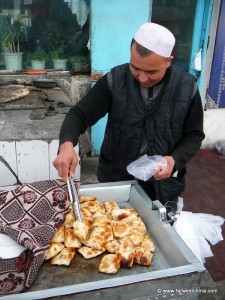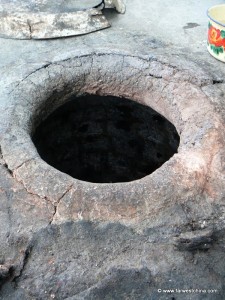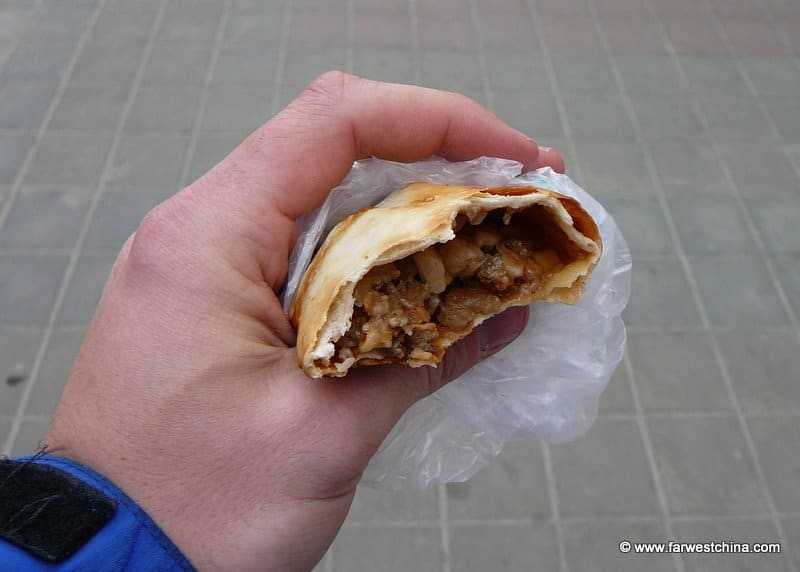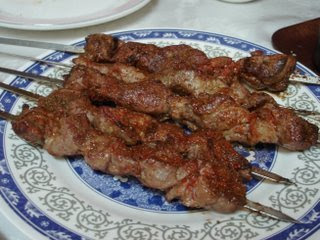Uighur Cuisine, Haymarket
I recently received a friendly email from Jenny, a GrabYourFork reader who, along with other recommendations, encouraged me to try Uighur food, available at a number of dedicated restaurants in Sydney's Chinatown. I had never heard of such a cuisine, and the fact that the Uighur people (also spelled as Uyghur and Uygur) lived in China, motherland of my ancestral heritage (although shamefully I have the linguistic capability of a tempestuous two-year-old), made me insatiably curious to check it out as soon as possible.
With fellow foodblogger Rebecca for photo-snapping company, we headed to Uighur Cuisine, located at the often-forgotten end of Dixon Street, crossing the lights at Goulburn Street and walking down the pedestrian mall past the old Chinese cinemas and the brand spanking new apartment complex.
The decor is remarkably familiar. Giant tapestries (or prints of them) on the walls, musical instruments mounted on vibrantly woven tapestry-backed frames, and a ceiling shrouded by a complex network of vine leaves and hanging grapes--plastic but spectacularly striking nonetheless.
I am no stranger to vine-leaved ceilings. They adorn many a noodle house in Chinatown, although me, in my oblivious cultural narrow-mindedness, had always dismissed them as some kind of bizarre form of cheap misguided Italian-themed decoration. When we ask our friendly waiter at Uighur Cusine the reason for the vines, he smiles, closes his eyes briefly, and speaks wistfully of the grape vines that grow in abundance where he comes from, how they line the streets with shade and cool shelter, and how his people love to sit underneath them, sharing in good meals and long conversations.
I feel so stupid. And I adore the vine leaves now because of this evocative description.
The menu is a pictorial A3 laminate, double-sided in blue and broken up into categories. There are so many options that we take about ten minutes to decide.
Hoshang $8.00
Braised and steamed Uighur dumpling (5 per serve)
We start with Hoshang dumplings which, from the menu photo, look like steamed pan-fried dumplings. They are quite heavy buns though, a stodgy theme that runs throughout much of their cuisine as we soon discover.
Inside the Hoshang dumpling
The buns are filled with a mixture of lamb mince and onion. The meat is unspiced and rather plain-tasting, although the unmistakable taste of lamb fat makes its presence known with its sticky texture and lingering mouthfeel.
Laghman Saomian $7.50
Uighur hand-made noodles stir-fried with vegetables and chicken
The Langhman Saomian is a fairly familiar dish of chewy handmade noodles stir-fried with onion, chicken and vegetables. Laghman or langman, I discover via Google, is apparently one of the most popular dishes in Uighur cuisine, often known as "a dish of love". Every dish in Uighur cuisine has symbolic meaning and acccording to tradition, love should last as long as the length of the noodles. Awwwwwww..........
Koy Gosh Kawapi $10.00
Lamb kebab (5 skewers)
Lamb plays an obvious major role in the diet of the Uighur people. Their reverence for lamb could not be more apparent than the menu's giant photo offer of Putun Koy Tonor Kawapi or a whole lamb kebab for $350.00, a hefty affair which unsurpisingly requires one week's notice. If that seems too generous one could elect the Pachak Kawipi lamb leg kebab for $75.00. Only one day's notice for that one.
For two people though, we opt for the Koy Gosh Kawapi which arrives as a generous serving of five lamb kebabs on flattened metal skewers.
These are meaty affairs encrusted with a spicy rub of chilli flakes, salt, black pepper and a uniquely Uighur herb known as zir. They have a pleasing chewy meatiness to them; they are not tough, but they are substantial, and the chilli flakes give some much welcomed life to my delighted tastebuds.
There are so many interesting-looking items on the menu, but there is only so much two foodbloggers can eat. So a few weeks later, with waistbands back to their pre-starchfest size, we head there again for a follow-up visit (we're becoming, like, professional food critics, no?).
Tawa Ban Shir $7.80
Fried dumplings
This time we try the Tawa Ban Shir or fried dumplings. These are distant cousins of Chinese dumplings or Japanese gyoza, although with the majority of Uighurs practising Muslims, pork is definitely an unwelcome stranger.
The dumpling are filled with a dense pocket of finely minced lamb, onion and some spring onions too. The medium-thickness skins are quite smooth, fried to a crisp on one side which contrasts nicely with the faint hint of soup within.
Manpar Saomian $7.80
Square-cut Uighur pasta with stir-fried vegetables and beef
I had been fascinated by the idea of square-cut pasta when perusing the menu on our last visit, so we order the Manpar Saomian this time. I had anticipated quite a thin supple noodle, slippery and silky like Chinese rice noodle sheets, but I am happy to discover that these are thick chewy wads of noodle, akin to, but not quite as filling as Chinese New Year cake. It is addictively more-ish for this lover of starch.
Palak Hum Sai $4.50
Spicy spinach salad
Remembering the distinct lack of vegetables from our last visit, we order a side of vegetables. There are a couple of options that catch the eye, including Alma Salat apple salad with sweeteners for $3.50; and Kawa Sama pumpkin samosa for $7.00. The Yaghda Pishirilgan Yangyo stir fried potato for $5.00 looks remarkably similar to a plate of French fries, but in the end we go for a simple spicy spinach salad or Palak Hum Sai.
The Chinese water spinach is a happy health-giving green and garnished with bright slivers of crunchy red capsicum. There's a distinct vinegary taste to this dish, which refreshes the palate and helps flush out the aftertaste of grease. We dip into this dish with much relief throughout our meal, particularly with respect to our final dish which arrives with a flourish.
Gosh Nun $10.00
Meat in special Uighur pastry
The Gosh Nun is a giant disc of meat-filled pie cooked in a cauldron. We ooh over the pretty golden crust, and the delicate pleats folded in along the edges.
Inside the Gosh Nun meat in special Uighur pastry
The pleats are a little dry and chewy though and the meat is unbelievably mutton-like for my palate. It's too fatty and tongue-congealing for my taste, but Rebecca thinks it's fine, although she's grateful for the vinegary spinach too.
There are a couple of other dishes which appeal to my adventurous tastebuds, things like Koy Till Salat lamb tongue in special sauce for $7.80; Burak Kormisi specially prepared kidney for $10.00; and Upkda Kormisi stir-fried lung for $15.00. Stuffed lungs, or lights, is apparently an Uighur delicacy. Butchers take care not to puncture the lungs, which are tested by inflating them, then they are filled with a stuffing of dough, milk, eggs and oil, tied up and cooked immersed in boiling water.
Our bill in Uighur
A Roman script was originally used in China with a new Arabic script
introduced in 1987. Cyrillic script has been used throughout.
The food is plain and yes there's plenty of lamb and lamb fat, but we make use of the DIY chilli sauce and down endless cups of tea. Staffed by close-knit family members, service was patient and extremely hospitable. They are a beautiful people too, with luminiscent pale skin, dark brown hair and thoughtful soul-searching eyes.
Other random facts I've learnt about the Uighur people this weekend on Google:
The Uighur are a Turkic people and one of 56 ethnic groups officially recognised by the People's Republic of China
There are over 7 million Uighurs in China (1990 census) with 4.7 million living in Xinjiang (sometimes known as East Turkestan), China's most remote province through which the Silk Road passes
Uighur communities can be found in Kazakhstan (300,000), Afghanistan (3,000), Kirgizistan and Uzbekistan. There is also a large Uighur community in Turkey.
Tea is an important tradition which is served in a myriad of ways with accompanying rituals. The Uighurs from the Seven River region make atkan cay tea with salt and milk. At breakfast it is served in big bowls with the addition of cream, sour cream and butter, turning it into a filling meal known as apqur cina.
The Uighur have more than 40 different methods of making bread
People live longer in the Uighur region than anywhere else in China. Of all the people who are over 100 years old in China, 25% of them come from Xinjiang.
See? All the lamb fat must be good for you.
Uighur Cuisine
Shop 1, 2 Dixon St, Haymarket, Sydney
(corner of Liverpool Street and Dixon Streets)
Tel: +61 (02) 9267 8555
 Back in the day my mom used to keep
a box of frozen food known as “Hot Pockets” in the freezer
ready to fight my insatiable appetite. It was never quite enough for a
full meal, but it would keep me out of the kitchen long enough for her
to cook a full-blown dinner. If I remember right there were different
flavors like broccoli and cheese, chicken and cheese, beef and onions,
and maybe even pepperoni pizza. I’m going to go out on a limb here and
say that I don’t think they ever thought of adding “lamb” as a flavor.
Back in the day my mom used to keep
a box of frozen food known as “Hot Pockets” in the freezer
ready to fight my insatiable appetite. It was never quite enough for a
full meal, but it would keep me out of the kitchen long enough for her
to cook a full-blown dinner. If I remember right there were different
flavors like broccoli and cheese, chicken and cheese, beef and onions,
and maybe even pepperoni pizza. I’m going to go out on a limb here and
say that I don’t think they ever thought of adding “lamb” as a flavor. Many times
you’ll find Samsa stands right next to stands that sell Uyghur
bread, and the reason for this (I guess) is because the ovens used
to cook them are almost identical. Wide at the base with a narrow
opening, these brick ovens are heated with either coal or wood,
whichever is more readily available in that particular region. Inside,
the oven walls are curved and smooth.
Many times
you’ll find Samsa stands right next to stands that sell Uyghur
bread, and the reason for this (I guess) is because the ovens used
to cook them are almost identical. Wide at the base with a narrow
opening, these brick ovens are heated with either coal or wood,
whichever is more readily available in that particular region. Inside,
the oven walls are curved and smooth.














































